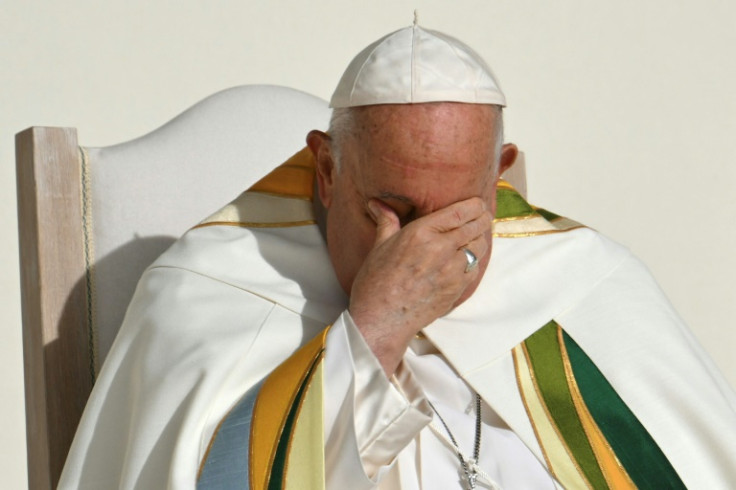Where Will Pope Francis Be Buried? Pontiff Reportedly To Be Laid At Santa Maria Maggiore

Speculation over Pope Francis' final resting place has intensified following reports that the Vatican has begun rehearsing his funeral as concerns about his health mount. Unlike his predecessors, who were buried beneath St Peter's Basilica, the 88-year-old pontiff has already prepared a final resting place that will break with tradition.
According to Swiss newspaper Blick, the Swiss Guard have been placed under curfew in preparation for the Pope's passing. The Vatican has yet to confirm these reports, but sources close to the pontiff say that he recently told confidants he 'might not make it this time' amid his battle with pneumonia.
Francis' Ailing Health Raises Concerns
The Pope was rushed to Rome's Gemelli Hospital on 14 February after experiencing significant chest pain. Despite resisting medical intervention for days, doctors diagnosed him with a complex respiratory infection involving asthmatic bronchitis and double pneumonia. Given that Francis had part of his lung removed at the age of 21, the infection has raised serious concerns among medical professionals.
'Laboratory tests, a chest X-ray, and the Holy Father's clinical condition continue to present a complex picture,' the Vatican stated. However, officials have not provided details on how he is responding to treatment beyond confirming that he is not currently running a fever.
Doctors have prescribed cortisone antibiotic treatment, and while the Pope has continued to eat meals and read newspapers from his hospital bed, some experts have warned that his lack of a fever may not be a good sign. Dr Carmelo D'Asero, a leading expert on infectious diseases in Rome, stated, 'A high fever is a sign of an immune response to a pathogen. Having a serious bronchial infection without one suggests a weakened immune system, which is concerning.'
Breaking with Tradition: Where Will Pope Francis Be Buried?
Unlike the majority of popes who have been interred beneath St Peter's Basilica, Pope Francis has reportedly made arrangements to be buried at Santa Maria Maggiore in Rome's Esquilino district. The basilica, one of the four major papal basilicas, has historically been the resting place of only seven popes, the last being Clement IX in 1669.
Francis' decision is a major departure from tradition, particularly in light of Pope Benedict XVI's burial in the Vatican grottoes in January 2023. Benedict's body was encased in three coffins—one of wood, one of lead, and one of zinc. In contrast, Francis will reportedly be laid to rest in a single zinc-lined wooden casket, per revised funeral rites issued last year.
Funeral Preparations Underway?
While the Vatican has not confirmed preparations for a papal funeral, sources claim plans are well underway. According to Politico, two people close to the Pope revealed that he has been actively 'tying up loose ends' to ensure continuity in his absence. Reports indicate that pilgrims have begun travelling to the Gemelli Hospital to pray for his recovery.
Despite speculation over his declining health, the Pope is still expected to lie in state at St Peter's Basilica before his funeral, following Vatican tradition. However, another significant change will be the absence of a catafalque, a traditional raised platform where deceased popes have previously been displayed. Instead, Francis' coffin will remain open until the night before his funeral.
A Departure from Centuries of Tradition
Since St Peter's Basilica was completed in 1626, more than 75% of popes have been buried in its grottoes. Pope John Paul II was originally interred in the Vatican crypt before being moved to the main floor of the basilica after his beatification in 2011. Pope John XXIII, who died in 1963, was buried in a marble sarcophagus beneath the basilica but was later placed in a glass casket for public viewing.
While Francis' burial at Santa Maria Maggiore represents a break from centuries of tradition, it is not entirely unexpected. The Pope has long demonstrated a deep connection to the basilica, frequently visiting to pray before and after international trips. He has made over 100 visits to the site, where he prays before an icon of the Virgin Mary and baby Jesus.
What Happens Next?
As speculation over Pope Francis' health continues, Vatican insiders believe his condition remains 'stable but concerning'. For now, no official timeline has been given for his potential return to public duties, but reports suggest that his schedule remains heavily restricted.
Regardless of when his time comes, Pope Francis' decision to reject the traditional burial site of his predecessors is yet another example of his willingness to break with convention. Whether his departure from papal burial norms will set a precedent for future popes remains to be seen, but one thing is certain: when the time comes, Francis will be laid to rest in a place of his choosing, not beneath St Peter's Basilica.
© Copyright IBTimes 2025. All rights reserved.





















